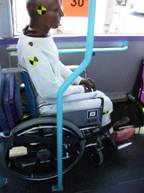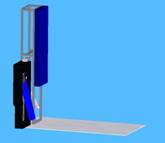The device developed in this project includes a backrest and a movable aisle-side containment structure. The operation would begin with the user backing into the securement space until the rear of the chair is in contact with the backrest. Activation of the aisle-side device would then provide the second side of containment; the bus wall would act as the third side.
Results of the previous Transit IDEA Project 38 showed that rear-facing wheelchair containment is feasible and desirable for bus transit operations. It provides an appropriate level of safety, allows wheelchair passengers full independence in riding the bus, and reduces the time required for bus driver assistance, which then substantially reduces in-vehicle dwell time. The limitation is the absence of a good means for aisle-side containment. One alternative in use is a fixed stanchion, as shown in Figure 1. However, this stanchion severely limits wheelchair maneuvering space, and it requires that the passenger has the ability to hold the stanchion. The other alternative does without aisle-side containment. This limits the use of the rear-facing option to those passengers in stable power chairs or to passengers able to securely hold on to a wall-side handhold.

Figure 1
An aisle-side stanchion provides containment, but limits maneuvering space.

Figure 2
A concept for an aisle-side armrest that is stored in the frame of the backrest until deployed. In this figure, the armrest is at the start of the deployment cycle.
Completed Investigation
This project developed a rear-facing wheelchair containment system for buses, including design, construction, laboratory testing, and refinements, followed by in-vehicle testing of a final prototype. This project included reviews by collaborators, including Lane Transit District (LTD) of Eugene, Oregon. LTD is an early implementer of Bus Rapid Transit (BRT) and has a fixed stanchion rear-facing wheelchair securement position on each of its new BRT vehicles, in addition to a front-facing wheelchair securement position.
Activities conducted this project included the following: design, solid model development, and virtual testing along with finite element analysis for strength, construction of a prototype for testing, laboratory testing for strength, cyclic testing for durability, and in-vehicle testing with regular wheelchair passengers of LTD.
Product Payoff Potential
It is anticipated that the results of this project will have a positive impact on the transit industry’s approach to wheelchair securement. The use of independent rear-facing containment will reduce the time and the operator assistance that are currently required when a wheelchair user boards a bus. This project provided information on effective rear-facing containment. It will provide data that could be useful in future consideration of an appropriate revision to the existing Americans with Disabilities Act (ADA) Accessibility Guidelines on rear-facing wheelchair containment for buses. This project will determined where aisle-side containment surfaces should be centered, what shape they should be, and how big they should be. It also determined the magnitude of the forces that aisle-side containment must withstand.
Product Transfer
The knowledge that is gained about independent wheelchair securement as a result of this project will be disseminated through the completed project final report, publication in appropriate journals, presentations at APTA conferences, other transportation conferences, and in meetings of the American National Standards Institute (ANSI) Committee on Wheelchairs and Transportation.
The contractor's final report is available.